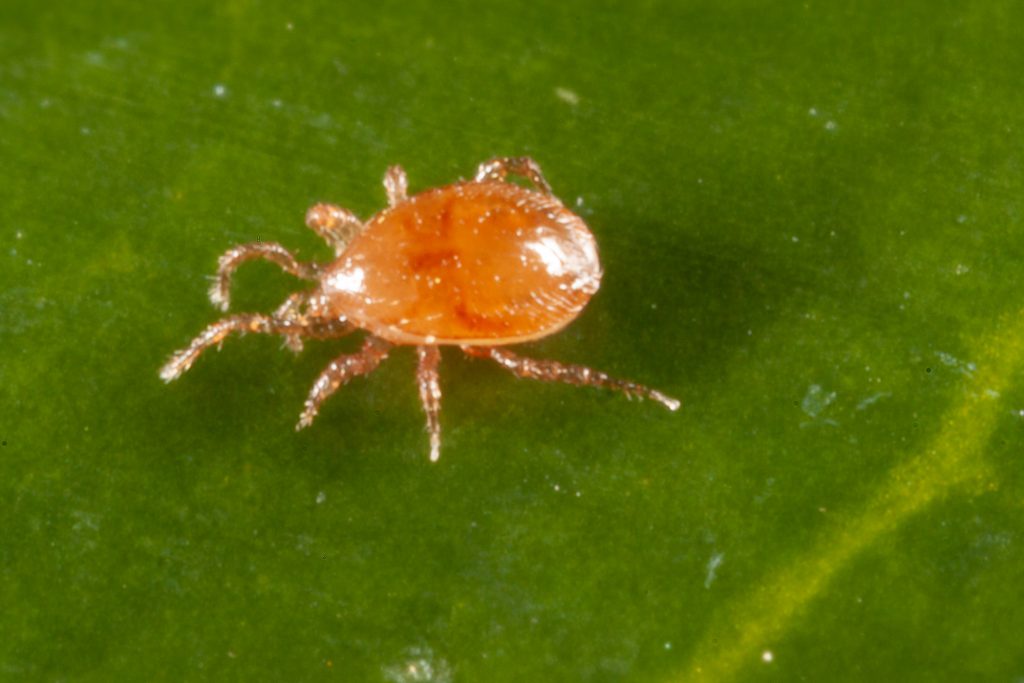Look out for predatory mites such as the red velvet mite. They are mostly vividly coloured and have prominent mouthparts. They will now be increasing in numbers after the initial outbreaks of pest mites.
Where have they been reported?
We have had two reports of red velvet mites within emerging crops in the past fortnight. The first group of mites was found in an emerging canola crop in Kerang in the Victorian Mallee, while the second sighting came from a barley crop west of Gunnedah in the North West Slopes & Plains of NSW.
About this beneficial mite
Red velvet mites belong to the family Trombidiidae.
There are many species of red velvet mites, however, all have the same bright red colour and often a velvety appearance due to a covering of short stout hairs on their body. The adults are relatively large, often more than 3 mm in length; nymphs look the same as adults but are smaller.
Interestingly, while red velvet mite nymphs and adults are predatory and will feed on small invertebrates living in the soil, the larval stage is parasitic on many different arthropods, including aphids.
Red velvet mites are highly visible due to their bright colour and relatively large size. However, they often go unnoticed because they spend most of their time burrowed in the upper soil particles or beneath the soil surface litter.
Other beneficial mites
Spiny snout mite (Neomulgus capillatus) and pasture snout mite (Bdellodes lapidaria)
Both the spiny snout mite and the pasture snout mite are generalist predators that can be effective in reducing pest populations in pastures, though less so in crops.
Both species have orange bodies and eight orange legs, and can be distinguished from pest mites because of the fast speed at which they move. Adults are approximately 2 mm long with a pointed snout.
In some situations, they are able to contain outbreaks of the lucerne flea in pastures and will also attack earth mites.
The pasture snout mite is native to Australia, while the spiny snout mite was imported from Morocco and the south of France to Western Australia and Tasmania, respectively.
The spiny snout mite has been found to be highly effective in reducing lucerne flea populations in Tasmania, while the pasture snout mite seems to be less effective.
Today, after natural and assisted spreading, these predatory mites are found right across the cool, higher rainfall regions of southern Australia.

Anystis mites (Anystis wallacei)
French Anystis mites were imported from southern France to Australia in 1965 as a biological control agent for redlegged earth mites.
In field trials, Anystis mites, in conjunction with the pasture snout mite, were found to effectively control redlegged earth mites and lucerne flea.
Anystis mites have red bodies, the adults are approximately 3 mm in length and they move in a circular motion (they are sometimes called whirligig mites for this reason!).
Nymphs look similar to adults except they are smaller.

Mesostigmata mites (Mesostigmata spp.)
Mites in the order Mesostigmata are mostly free-living predators in soil and litter, on the soil surface or on plants.
They contribute to the control of mite pests and lucerne flea although they are unlikely to be solely effective in controlling populations.
Adults are approximately 4 mm in length, and those species that are commonly seen are either cream to orange or brown in colour.
Like other predatory mites, mesostigmatids are typically highly mobile and have prominent mouthparts compared with pest mites.

Ways to increase the effectiveness of predatory mites in crops
Predatory mites are relatively slow to disperse because they move only be crawling. In Tasmania, the spiny snout mite was observed to spread at a rate of about 70 m per year.
Hence, to conserve predatory mites choose selective insecticides and leave shelter belts or refuges between paddocks to help maintain beneficial mite populations.
Acknowledgements
Sources of field reports of red velvet mites
Bronwyn Hunt – Merriwa Pastoral Company, Kerang (Victorian Mallee)
Rob Weinthal – Principal Agronomist, RAW Agriculture (North West Slopes & Plains)
References
Ireson JE and Webb WR. (1995). Effectiveness of Neomolgus capillatus (Kramer) (Acarina: Bdellidae) as a predator of Sminthurus viridis (L.) (Collembola: Sminthuridae) in northwestern Tasmania. Journal of the Australian Entomological Society 34: 237-240.
Michael PJ. (1995). Biological control of redlegged earth mite and lucerne flea by the predators Anystis wallacei and Neomolgus capillatus. Plant Protection Quarterly 10: 55-57.
Beaulieu F and Weeks AR. (2007). Free-living mesostigmatic mites in Australia: their roles in biological control and bioindication. Australian Journal of Experimental Agriculture 47: 460-478.
Cover image: Photo by Daniel Andrews





